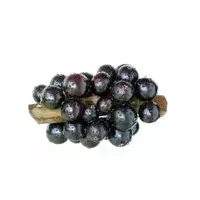Jaboticaba

Jaboticaba is a truly amazing plant, a distinctive feature of which is the condition for the formation of its fruits. Kaulifloria - under this name, a natural phenomenon is known when flowers, and then fruits appear not only on the main branches, but also on the trunk of the plant.
Meanwhile, jaboticaba is called an evergreen tree, the height of which under favorable conditions reaches 12 meters. Unfortunately, it grows very slowly, but as a result it pleases with its appearance: oval-lanceolate glossy leathery leaves and snow-white inflorescences simply look amazing against the background of a massive trunk and spreading branches. By the way, quite often jaboticaba is grown in indoor conditions in the form of a decorative tree.
The plant is found in both wild and cultural form in Paraguay, Southern Brazil, Northern Argentina and Bolivia. In addition, the countries where the jaboticaba is currently naturalized are Uruguay, Colombia, Panama, Peru, Cuba and the Philippines.
The fruits of the jaboticaba in mature state are round or elliptical drupes, glossy maroon-purple, almost black, in color. Moreover, at the tips of these berries, which I resemble grapes, there are remnants of sepals. Inside the jaboticaba there is white or pink jelly-like translucent flesh, which has increased juiciness. So, the fruits grow in clusters, covering the trunk and the main branches of the tree.
As in appearance, the taste of jaboticaba berries is very similar to wild grapes with its characteristic delicate acid along with a tangible sweetness. By the way, special substances that are contained in the skin of mature fruits allow you to use this berry as a natural dye in the production of soft drinks and wines - they give the product a deep red color.
The pulp of the jaboticaba fruit is edible not only fresh, but also processed. They are based on marmalade, jelly, juices, jam, as well as local types of alcoholic beverages. However, due to the fact that fermentation processes begin three days after the removal of berries from the tree, mature fruits are not subject to long-term storage, but represent a good basis for preparing strong liquor or wine.
In addition, in Brazil, a decoction of dried fruit skin is used as a remedy for diarrhea, asthma and dysentery. Jaboticaba berries can also be used to treat inflamed tonsils. And due to the fact that scientists have discovered some anti-cancer components in the composition of these exotic fruits, it is likely that jaboticaba is used as a natural remedy in the fight against this terrible disease.
jaboticabs 49 kCal
Energy value of jaboticaba (Ratio of proteins, fats, carbohydrates - ju):
Proteins: 0.8 g (~ 3 kCal)
Fats: 0.3 g (~ 3 kCal)
Carbohydrates: 9.6 g (~ 38 kCal)
Energy ratio (bj | y): 7% | 6% | 78%
 Español
Español Français
Français Português
Português Русский
Русский 简体中文
简体中文 繁體中文
繁體中文 日本語
日本語 한국어
한국어 العربية
العربية Türkçe
Türkçe Қазақ
Қазақ Deutsch
Deutsch Italiano
Italiano Українська
Українська
